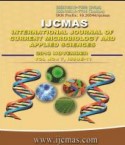


 National Academy of Agricultural Sciences (NAAS)
National Academy of Agricultural Sciences (NAAS)

|
PRINT ISSN : 2319-7692
Online ISSN : 2319-7706 Issues : 12 per year Publisher : Excellent Publishers Email : editorijcmas@gmail.com / submit@ijcmas.com Editor-in-chief: Dr.M.Prakash Index Copernicus ICV 2018: 95.39 NAAS RATING 2020: 5.38 |
Mutation breeding is one of the best ways to induce genetic variability within a crop species in a short period of time. It is equally a potentially powerful tool for cluster bean as other crops for genetic enrichment. The gamma radiation induced 190 M4 mutant lines of cluster bean [Cyamopsis tetragonoloba (L.) Taub.] obtained from Centre for Biotechnological Research (CBR), Dept. of BCI, College of Horticulture, Bengaluru and which were used for the field experiment on spikelet sterility during kharif 2017 (June - November) at College of Horticulture, Mysore. The present investigation revealed the presence of the 12 sterile mutant lines viz., A5, A16, A23, B52, B60, B61, C93, C94, C102, D124, D136 and D141. The sterile mutants morphologically differ from fertile mutants in flowering, pod setting and development vegetative growth. There was no or very less amount reproductive growth is noticed in these mutants with small rudimentary like pod growth and 1 or 2 pods are observed with 1 to 3 seeds per pod with very long vegetative growth. The sterility was confirmed through visual observations and the pollen fertility percentage was recorded by doing the acetocarmine smear test. The stained pollens are considered as fertile and non-stained pollens are sterile because the pollens are non-viable in case of sterile plants and the fertile mutants are observed with 82.02% (D160) to 99.72% (D163) per cent pollen fertility while, the pollen fertility was 5.06% (B60) to 10.04% (D141) in case of sterile mutant plants.
 |
 |
 |
 |
 |